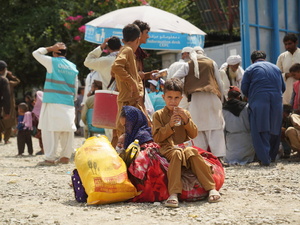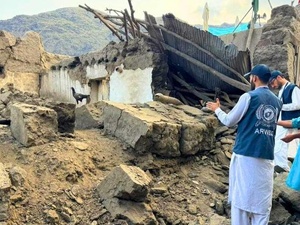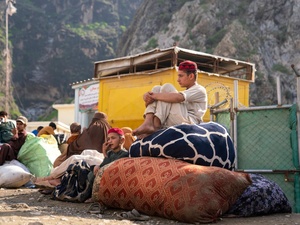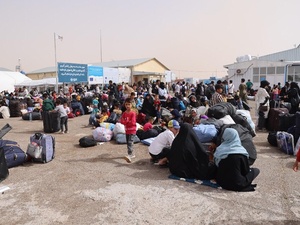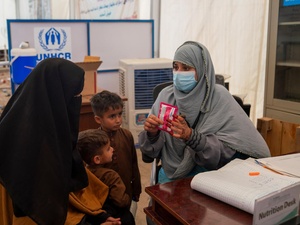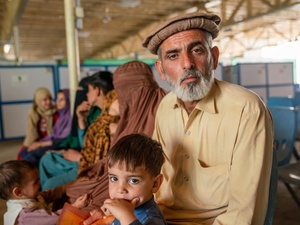Afghanistan Humanitarian Update No. 65
Afghanistan Humanitarian Update No. 65
10 September 2002
At a Glance:
- Largest repatriation since 1972
- Rural assistance programmes
- Internally displaced Afghans
- Winter challenge
- Transition from relief to reconstruction
- Returns alter Pakistan's cityscapes
Largest repatriation since 1972
Since the end of winter more than 1.6 million refugees have returned with UNHCR help from Iran, Pakistan and the Central Asian states. Another more than 230,000 internally displaced persons (IDPs) have also been assisted homewards. Planners now believe that some 2 million people will return this year.
Many other Afghans have not waited: some 400,000 people - both refugees living abroad and IDPs - have gone back under their own steam to rebuild their communities.
The voluntary return of so many Afghans is the largest repatriation the UN refugee agency has assisted since 1972, when more than 9.8 million people who had earlier fled East Pakistan were returned to Bangladesh.
While thousands of Afghan refugees still return daily, the rate is rapidly declining as night-time temperatures begin to drop. During August, about 196,000 refugees returned home compared to the peak of over 412,000 refugees in May. Returns from Pakistan declined sharply in August.
| Assisted returns* | Returns by asylum country | ||
|---|---|---|---|
| March: April: May: June: July: August: | 121,000 279,000 412,000 292,000 303,000 196,000 | Pakistan Iran Central Asian states | 1,465,000 185,000 10,000 |
(*UNHCR-assisted returns.)
An increase in the number of refugees returning from Iran has coincided with an apparent effort by government officials to encourage Afghans to repatriate. The number of refugees leaving Iran last month more than doubled to 62,000 people, bringing to 185,000 the number of UNHCR-assisted returnees since April. Another some 58,000 Afghans have returned spontaneously.
The sudden fall of the Taliban regime in late November 2001 and the establishment of the Afghan Interim Administration under the Bonn Agreement apparently encouraged many long time refugees to go home.
UNHCR quickly responded to the new developments, moving its operational headquarters from Islamabad back to Kabul in January and rapidly re-establishing and expanding its field presence.
In March, UNHCR and the Afghan Ministry of Repatriation launched an assisted repatriation programme to help voluntary returnees. The two agencies initially planned to help 1.2 million refugees and internally displaced people get home this year, a figure many thought was too optimistic. In fact, the figure turned out to be a vast underestimate.
Regardless of the strong will of the Afghans to return to their homes, UNHCR considers that security and living conditions in Afghanistan are not yet wholly satisfactory at this time to encourage all refugees to repatriate.
The agency currently operates 30 offices throughout Afghanistan to coordinate protection and assistance activities. Key sub-offices are located in Kabul, Mazar-i-Sharif, Herat, Kandahar and Jalalabad. UNHCR has 630 staffers in the country, of whom 540 are national staff.
By July the agency had spent more than $163 million out of its $271 million budget for the Afghan repatriation and refugee assistance in the seven surrounding countries. The agency has received 91 percent of its budget, or more than $246 million. With millions of Afghans still outside their country and many others still internally displaced, UNHCR's task and the challenge to aid the Afghans will be a multi-year effort requiring strong donor support.
The UN refugee agency's repatriation programme aids returning refugees with basic relief items so they can begin rebuilding their lives in communities devastated by years of conflict and persistent drought.
Upon arrival in Afghanistan, UNHCR provides returnees with a transportation allowance ranging between $5 and $30 per person, depending on how far they have to travel. The Ministry of Repatriation and UNHCR operate 10 encashment centres and 22 aid distribution points throughout Afghanistan to support Afghans returning under the joint initiative. Families receive at least 50 kg of wheat flour from the World Food Programme and a household package from UNHCR consisting of plastic sheeting, soap and hygiene cloth. The distribution of blankets and jerry cans was stopped in mid-August to ensure remaining stocks aid the larger number of returning families.
Before returning, refugees requesting repatriation assistance are first screened at repatriation centres. In Pakistan, some 68,000 families representing more than 300,000 persons have been refused assistance after interviews determined that they were "recyclers" interested in obtaining UNHCR's relief package and WFP food aid without intending to remain in their homeland.
The original exodus of Afghan refugees began in 1979 during the Soviet invasion, however, many families have fled multiple times during the 23 years of war. The number of refugees peaked in 1990, with 6.2 million people outside the country. UNHCR assisted returning Afghans throughout, but the plight of millions of Afghans had been ignored for much of the last decade until the terrorist attacks in the USA on 11 September 2001 and the subsequent intervention in Afghanistan.
Rural assistance programmes
Many Afghans are returning to villages that have been destroyed during the 23 years of conflict and where livelihoods were devastated by the long drought. At the beginning of the assisted repatriation, UNHCR agreed with the government to prioritise assistance in rural areas.
The agency also provides shelter material to assist vulnerable returnee families construct their homes. Shelter kits consisting of a door, two windows, timber, nails, hammer, shovel, door hinges and pick axe for building two-room-houses are provided to over 41,000 households, benefiting up to 400,000 people. Some 20 NGOs are working with the Repatriation Ministry and UNHCR to deliver shelter kits throughout the country.
| Planned shelter kits (households)* | |
|---|---|
| Central: East: North: West: South: | 13,500 9,300 7,300 5,200 1,100 |
Provision of water is crucial for returning families restoring their communities, and UNHCR has contracted the construction or deepening of nearly 2,800 wells, setting up over 270 latrines and restoring some water pipes and canals.
The implementation of shelter and water projects has not been easy during this first post-Taliban year. Aid agencies have had little time to get re-established between the sudden changes in Afghanistan in November, and the mass inflow of Afghans that began shortly thereafter. Many agencies have limited ability to work in isolated areas where the existence of mines and security problems hamper their activities.
Internally displaced Afghans
Some 230,000 displaced Afghans have so far returned home from elsewhere inside the country with assistance from UNHCR, the International Organization for Migration and other partner agencies. More than 200,000 other IDPs have opted to return spontaneously. There are still an estimated over 920,000 IDPs scattered throughout Afghanistan.
| Regional breakdown of IDPs | |
|---|---|
| North: South: Centre: East: West: | 154,000 306,000 210,000 190,000 66,000 |
| Est. Total IDPs: | 926,000 |
UNHCR's strategy has been to focus assistance in areas of return to better help both returning refugees and IDPs to reintegrate.
Minority communities are a concern to both the Transitional government and UNHCR. In some areas of northern Afghanistan, Pashtuns in particular have been forced to leave their homes due to insecurity and ethnic tensions. Around Afghanistan's southern border with Pakistan - Spin Boldak and Chaman - there are now an estimated 60,000 displaced Afghans. Some are Pashtuns who fled the north, while others are nomadic Kuchi families who lost their livestock due to conflict and drought and who are now dependent on aid.
The UN High Commissioner for Refugees, Mr. Ruud Lubbers, and the Minister of Repatriation, Mr. Enayatullah Nazari, met with the displaced people in Spin Boldak late August. They assured the displaced Afghans that the Transitional Authority will work to improve the conditions in the north, but added that restoring security and reversing the effects of drought takes time. In a positive development, authorities in the North and the Kabul government have agreed to set up a consultation mechanism to allow eventually the return of minority communities.
Meanwhile, in a move requested by both the Afghan and Pakistan governments, UNHCR has begun relocating stranded Afghans from the squalid Chaman border camp to a temporary site in Zhare Dasht, west of Kandahar, where the displaced families can be better assisted. More than 900 families have already voluntarily moved to the new site.
Winter challenge
The race is on to ensure Afghans who may find themselves severely affected by the harsh winter season get needed aid. Afghan government and UNHCR specialists estimate that up to 550,000 people may be particularly exposed to hardships during the cold season in Afghanistan.
About 290,000 returnees could find themselves in desperate straits, particularly people who go home late in the year, when access and transport in remote areas could become more difficult. Another 260,000 IDPs, agencies estimate, could face grave difficulty as villages in Afghanistan's central highlands become almost inaccessible due to heavy snow.
UNHCR is currently stockpiling items to prepare for winter emergency. The agency already has set aside 4,500 tents, 15,400 stoves, 116,000 blankets and 34,000 plastic sheets. Additional items are being ordered, along with some 7,000 tons of charcoal. Other aid agencies are looking to provide food and planning to clear access roads and assist destitute groups under the Kabul government's plans to address winter-time needs.
Transition from relief to reconstruction
When High Commissioner Lubbers met with President Karzai in late August, both recognised the need to strengthen ties between humanitarian relief and rehabilitation/reconstruction projects. UNHCR and other humanitarian agencies are helping returning Afghans cope with the initial stage of reintegration, but there is a need to better link humanitarian aid to rehabilitation assistance. Beyond their immediate needs for water and shelter, recent returnees say they need schools, medical facilities, irrigation systems and ultimately, jobs to sustain them back in their homeland.
In addition to its ongoing work with the Ministry of Repatriation, UNHCR has begun talks with two other ministries - the Ministry of Urban Planning and the Ministry of Reconstruction and Rural Development. The government urgently needs to devise a returnee reintegration strategy that will better link relief and development, as the needs of returning Afghans must be incorporated in the country's reconstruction schemes.
Returns alter Pakistan's cityscapes
UNHCR long estimated that Pakistan hosted 2 million Afghan refugees. Following the return of more than 1.4 million people so far this year - more than three and half times the number initially anticipated - Pakistan's government now believes there are some 1.8 million Afghans still in the country. Although still large, this is far below the more than 3.4 million Afghans the government estimated when the repatriation programme began in March.
In the case of Islamabad, the impact of the massive repatriation has been visible. Early in the repatriation programme, the number of Afghans in the capital was estimated at 150,000. But a census by the Government of Pakistan completed in August concluded that only 29,128 refugees remain in Islamabad, about 20 percent of the original total. Other cities like Peshawar have seen their Afghan population similarly reduced by the massive repatriation.
Of the more than 1.4 million Afghans returning from Pakistan who sought UNHCR repatriation assistance, ethnic Pashtuns were the majority, followed by ethnic Tajiks, Hazaras, Uzbeks and Turkmen - a reflection of the overall Afghan population. Kabul remains the main destination.
Of those going home, 74 percent lived in urban areas; far fewer Afghans repatriated from the old established refugee settlements and the new camps in the border belt.
At the beginning of this year's assisted repatriation, refugees living outside camps accounted for half of Pakistan's Afghan residents. According to the UNHCR estimates, Afghans living in urban areas now comprise only 27 percent of the total number of refugees, with 63 percent living in the long-time refugee settlements. The new camps in Pakistan's frontier regions, where there is more extensive UNHCR assistance, now account for 10 percent of Pakistan's Afghan population.


